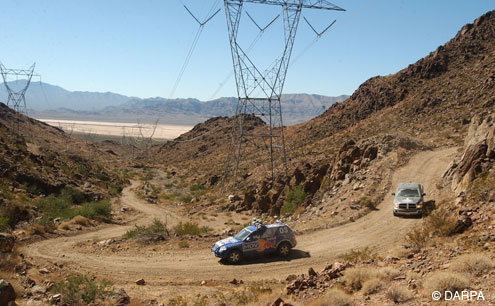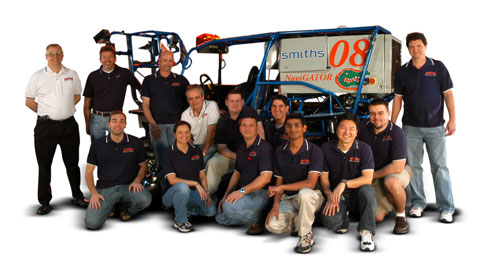|
|
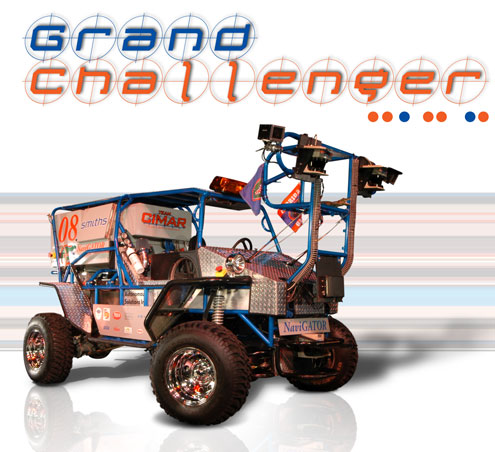 UF's robotic car, NaviGATOR, competed in the race for a $2 million prizeBy Aaron Hoover In the first national robot car race two years ago, the best-performing contestant traveled seven and a half miles — an almost laughably short distance because the course was 142 miles. The University of Florida’s entry, a modified 1993 Isuzu trooper, came in eighth. But NaviGATOR traveled just six tenths of one mile before running off the road and becoming ensnared in barbed wire. And that was its longest run ever. Eighteen months later it was obvious at the second Defense Advanced Research Projects Agency (DARPA) Grand Challenge in the tiny town of Primm, Nev., on the California border that the “bots” had come a long way. Twenty-three teams from universities and private companies were in Primm for the early-October robot race redux, all of them finalists who emerged from grueling pre-qualifying examinations and events. At ground zero, a parking lot behind an enormous hotel dolled up as a faux red barn called Buffalo Bill’s Casino and Resort, cars ranged from Highlander, one of Carnegie Mellon University’s two extensively modified Hummers, to TerraMax, a 16-ton U.S. Marine truck, to CajunBot, a pipsqueak six-wheeled affair. Where last year’s entries often smacked of high school science projects, 2006’s were sleek and polished, seemingly a prototype or two away from production.
With its shiny blue tubular steel frame and nested arrays of electronics, this year’s NaviGATOR looked like a spiffy, juiced-up, off-road go-cart. If its exterior was showroom quality, its electronics and mechanicals were much improved. In the months of testing that led up to the latest race, NaviGATOR traveled 40 miles in one test run, stopping only when it reached the end of its pre-planned route.
The dozen-or-so members of Team CIMAR, named for UF's Center for Intelligent Machines and Robotics, were proud of their overhaul. But the 12-hour days, breakdowns and assorted tribulations also made them intimately familiar with the extraordinary difficulty of the race. "There's perception, decision making and control, and if you screw up any one of those you're going to get stuck or fall off a cliff," said Bob Touchton, a mechanical engineering doctoral student. Sensing NothingDARPA, which before the Grand Challenge publicity blitz was an obscure Department of Defense think tank, said its goal in sponsoring the event was to accelerate the development of robotic vehicles for military purposes. Like other defense department agencies, DARPA is on a tight deadline: the military wants 30 percent of its vehicles under robotic or "autonomous" control by 2015.
The agency didn’t expect anyone to come up with a production military vehicle. Instead, it wanted to prove that functional robotic vehicles could be built. “Our job is to take the technical excuse off the table, so people can no longer say it can’t be done,” said DARPA Director Tony Tether at the national qualifying event held in California 10 days before the race, according to published reports. That looked like a failure after the first Grand Challenge. But DARPA upped the ante from $1 million to $2 million and the contestants redoubled their efforts.
At the helm of the UF team were Carl Crane, a UF professor of mechanical engineering, and David Armstrong, project manager and a UF engineer. Crane is the head of CIMAR and UF’s chief robot researcher. Armstrong is a mechanical whiz kid who has defined his life with evermore-outsized projects. At 15, he built a fort complete with a basement, phone and alarm system. In high school, he restored a 1969 Firebird convertible. After that, he started his own business, a medical clothing store, and built his family’s 5,000-square-foot home in Alachua. “I like a challenge. That’s the way I am,” Armstrong says, echoing a mantra repeated almost verbatim by other team members. Crane and Armstrong put their heads together with a half-dozen UF doctoral students and team members Mike Griffis, of Eigenpoint, a Florida robotics company, and staff members of the Utah-based robotics company Autonomous Solutions. They decided to craft a new NaviGATOR from the wheels up. The team hired All Terrain Monsters, a Georgia company, to build the car’s tubular blue frame and mount a four-cylinder Honda power plant. After the company delivered the skeleton in December 2004, the team spent the winter and spring installing and testing 10 computers, three cameras, three laser range scanners, one radar, two GPS units and a “North Finding Module” donated by sponsor Smiths Aerospace, a Grand Rapids, Mich.-based engineering firm.
Those electronics — and more — were aimed at helping NaviGATOR see the landscape, avoid collisions and move speedily toward its destination. For the robot, the frontline devices were the sensors, which had two roles: finding obstacles and following the road. One laser range scanner on the car’s bumper swept a laser 60 meters ahead, 70 times per second. Another, placed atop the car, scanned the terrain ahead in search of the road. The third hunted potentially fatal grades at the roadside. Each sensor presented its results in virtual grids designating potential obstacles, free space and roadside with “good” and “bad” numbers. The numbers went to a device called a smart arbiter, which analyzed the grids to pick the best numbers and best single grid. The sensors were pretty good at sensing obstacles such as boulders. But they had more trouble with “negative” obstacles such as holes — things that aren’t so much presences as absences. That worried some team members. “You have to sense nothing,” explained doctoral student Sanjay Solanki. “Not many people have come up with good ideas on this problem, but everybody is facing it.” Computers picked up the smart arbiter’s information and compared it to navigational waypoints provided by DARPA, picking the least-risky, most on-target path. The computers sent their decisions to actuators that actually controlled the throttle, brake and steering. All of it happened at an incredible pace. Armstrong said NaviGATOR constantly considered 5,000 potential paths and manipulated throttle, brake and steering 30 times per second. After the race itself, Armstrong said team members counted 20 million messages exchanged between NaviGATOR’s computers. For UF and other select teams, the months of building and testing paid off. Originally, 195 teams applied to DARPA for the second Grand Challenge. The agency culled the list to the best 118, then sent staff to assess each team’s efforts in the spring. By that time, NaviGATOR was doing laps around a test track in Citra. In June, UF made the cut of 40 semifinalists. Three months later, at the National Qualification Event in Fontana, Calif., NaviGATOR completed three out of five runs. That was good enough to snare it a spot in the main event but hardly the best of the lot. Stanford’s top-ranked Stanley completed all qualifying runs without a hitch. 23 Miles
It was 5:23 a.m. on race day and still dark outside the modest white truck trailer that doubled as Team CIMAR’s mission control and NaviGATOR’s garage. Armstrong, doctoral student Danny Kent and technician Sarah Gray were huddled over laptops checking out the “RDDF” — an electronic map of the course containing 3,000 GPS waypoints that Grand Challenge organizers had handed to the team a few minutes earlier. Armstrong programmed NaviGATOR’s speed and path for each leg of the course, which traveled 131.6 miles through a mountain pass, dry lakes and tunnels. The job was a tough one because if speeds were too low, NaviGATOR would have no hope of winning in the allotted 10 hours. But if speeds were too high, NaviGATOR’s chance of hitting something or running off the road went up. The opening ceremony at the gate started at 6:20 a.m. Bleachers were packed with team members, families and dozens of media representatives, including reporters from network television and the nation’s largest newspapers. After Tether gave a brief speech, the event, organized as a race against the clock, got under way. The robots’ departures were staggered, with those that performed best at qualification first out of the gate. Carnegie Mellon’s Highlander, a modified red Hummer with a Star Trek-like dish on top, left at 6:40 a.m. The driverless car turned by the grandstand and headed out into the desert with almost eerie confidence. Other cars followed in 10- to 20-minute intervals. By 8:50 a.m., four cars had already washed out and were declared “dead bots.” Shortly after 9 a.m., Kent led everyone in a rousing version of the Gator fight song, and NaviGATOR left the gate. After initially peeling off into the desert, the robots circled around and made another pass by the crowd. At 10:15 a.m. NaviGATOR roared past at top speed to cheers from the UF team. After following the road for awhile, it stopped and did a couple of unexpected loops in the dirt that clearly were not part of the plan. “Come on, get back on the road again!” Kent urged, cheering when NaviGATOR regained the road and headed in the right direction.
NaviGATOR next flawlessly traversed a bridge over a railroad track and disappeared into the brown desert haze. Shortly before 11 a.m., the team got word from the chase truck following NaviGATOR that the car had inexplicably run off the road and stopped. After several attempts to pause and restart the robot, the chase driver called back to say the car was moving, but slowly and off the road. Another call a few minutes later revealed that the robot had picked up speed and was following the road perfectly. But the good news didn’t last. After another mile, the car again got off the road and stopped in front of a bush. This time, DARPA quickly declared NaviGATOR dead. The time was shortly before noon. NaviGATOR had traveled 23 miles. Time and MoneyAt day’s end, NaviGATOR placed 18th among the 23 finalists. Five teams actually completed the entire course, with Stanford’s Stanley taking the $2 million prize for the shortest time of six hours, 53 minutes and 58 seconds.
Team CIMAR’s postmortem revealed the cause of the car’s problem was a failed GPS system, which reported a position that was almost 10 feet off — prompting NaviGATOR to drive off the road. Armstrong said the car’s sensors should have helped it recover, but the car’s last position was a high-traffic area, and DARPA officials were quick to declare it dead and move it out of the way so other robots didn’t collide with it. In the days following the race, media reports touted the outcome as evidence of a breakthrough. But Armstrong has a different assessment. He says most of the contestants used similar technology, but what separated them was the hours and dollars they were able to spend synthesizing that technology and working out the bugs. Team CIMAR’s $250,000 budget of cash and donated equipment was just a fraction of the sum spent by other top teams. “The truth is, it was just a matter of time and money,” Armstrong said. “The technology has been around for a long time. None of the teams had the time or money in the first go-around to get it all put together. In the second race, most teams still didn’t have it quite done. We were about 90 percent.” DARPA is currently working on developing a follow-up to the Grand Challenge that may involve robotic ground vehicles in an urban environment. As for NaviGATOR, Armstrong said CIMAR would fold many of its systems into an ongoing research effort for the U.S. Air Force. The goals of the project include a robotic helicopter and a robotic ground vehicle that can serve as a sentry for nuclear weapons facilities, he said. The car has also become a mechanical ambassador of sorts for the UF College of Engineering. Responding to an invitation this winter, for example, Armstrong brought it to the nation’s capital for display at the Washington Auto Show. NaviGATOR’s most enduring legacy may be the opportunity the project provided for doctoral students. Like several others, Touchton will base his thesis on the work he did on the car. “Where do you find a lab like this?” he asks. “This is like night and day with what we could have contrived in a laboratory.”
Carl Crane David Armstrong Related Web Sites
|
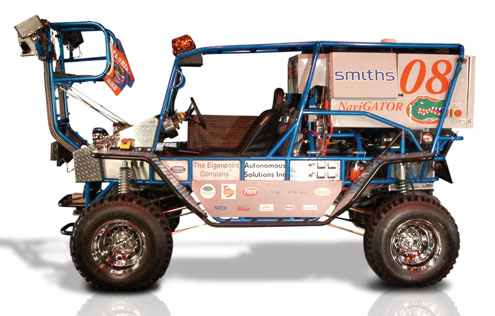


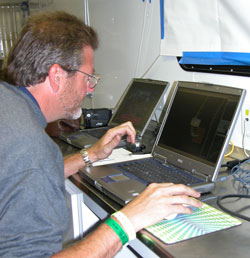
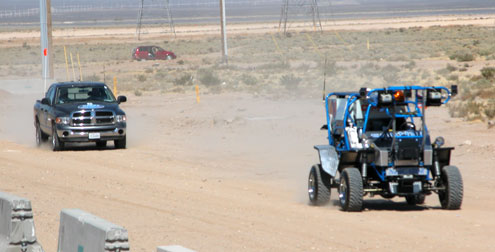
.jpg)
